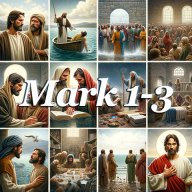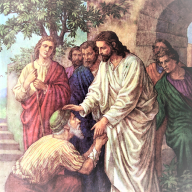- The Messianic
Secret
- Discipleship and
Misunderstanding
- The Suffering
Messiah
- The Kingdom
of God
- Authority and
Conflict
- Immediate Action
and Miracles
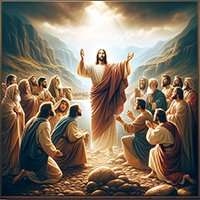 One of the most prominent themes in Mark's Gospel is the "Messianic Secret," the idea that Jesus' true identity as the Messiah and Son of God is to be concealed from most characters within the narrative, including demons, his disciples, and the crowds. This theme is evident in numerous instances where Jesus performs a miracle and then instructs those involved not to tell anyone. The purpose behind this secrecy has been a subject of scholarly debate, but it is generally understood as a means to focus on Jesus' teachings and actions, rather than on a premature revelation of his divine status.
One of the most prominent themes in Mark's Gospel is the "Messianic Secret," the idea that Jesus' true identity as the Messiah and Son of God is to be concealed from most characters within the narrative, including demons, his disciples, and the crowds. This theme is evident in numerous instances where Jesus performs a miracle and then instructs those involved not to tell anyone. The purpose behind this secrecy has been a subject of scholarly debate, but it is generally understood as a means to focus on Jesus' teachings and actions, rather than on a premature revelation of his divine status.
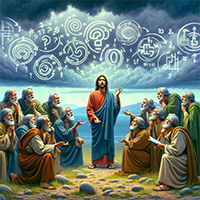 Mark’s Gospel presents a stark portrayal of the disciples who frequently misunderstand Jesus’ teachings and mission. This theme of misunderstanding or failure is crucial in Mark’s portrayal of discipleship. It emphasizes human fallibility and the difficulty of truly comprehending and following Jesus’ message. This theme culminates in the disciples’ failure to stand by Jesus during his arrest and crucifixion, highlighting the cost and challenges of true discipleship.
Mark’s Gospel presents a stark portrayal of the disciples who frequently misunderstand Jesus’ teachings and mission. This theme of misunderstanding or failure is crucial in Mark’s portrayal of discipleship. It emphasizes human fallibility and the difficulty of truly comprehending and following Jesus’ message. This theme culminates in the disciples’ failure to stand by Jesus during his arrest and crucifixion, highlighting the cost and challenges of true discipleship.
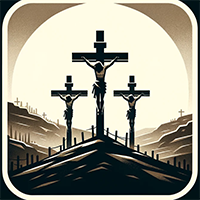 Unlike other Gospels, Mark emphasizes Jesus' suffering, particularly in the prediction of his passion and the narrative of his crucifixion. This focus on suffering serves to redefine messianic expectations – presenting the Messiah not as a conquering hero but as a suffering servant. This theme is central to Christian theology, underscoring the idea that Jesus’ suffering and death were integral to his mission of salvation.
Unlike other Gospels, Mark emphasizes Jesus' suffering, particularly in the prediction of his passion and the narrative of his crucifixion. This focus on suffering serves to redefine messianic expectations – presenting the Messiah not as a conquering hero but as a suffering servant. This theme is central to Christian theology, underscoring the idea that Jesus’ suffering and death were integral to his mission of salvation.
 The proclamation of the Kingdom of God is a central aspect of Jesus' teaching in Mark. The Kingdom is portrayed as a present reality and a future hope, a realm where God's will is done completely. Jesus' miracles are signs of the Kingdom's presence, offering a glimpse into a world where sickness, death, and evil are overcome. This theme offers hope and a new vision of the world to Mark's audience, especially in the context of suffering and persecution.
The proclamation of the Kingdom of God is a central aspect of Jesus' teaching in Mark. The Kingdom is portrayed as a present reality and a future hope, a realm where God's will is done completely. Jesus' miracles are signs of the Kingdom's presence, offering a glimpse into a world where sickness, death, and evil are overcome. This theme offers hope and a new vision of the world to Mark's audience, especially in the context of suffering and persecution.
 Mark frequently depicts Jesus in conflict with the religious authorities of his time, such as the Pharisees and Sadducees. These conflicts often revolve around issues of religious law and authority. Jesus is portrayed as having supreme authority – not just in teaching and interpreting the law, but also over nature, demons, and even death. This assertion of Jesus' authority challenges existing religious and social structures and forms a significant part of the Gospel's narrative tension.
Mark frequently depicts Jesus in conflict with the religious authorities of his time, such as the Pharisees and Sadducees. These conflicts often revolve around issues of religious law and authority. Jesus is portrayed as having supreme authority – not just in teaching and interpreting the law, but also over nature, demons, and even death. This assertion of Jesus' authority challenges existing religious and social structures and forms a significant part of the Gospel's narrative tension.
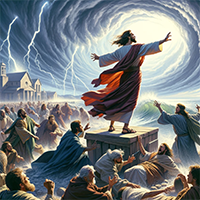 Mark's Gospel is characterized by a sense of immediacy and action. This is evident in Mark’s frequent use of the word "immediately" and in the rapid progression of events. This brisk pacing contributes to the dramatic impact of the narrative and underscores the urgency of Jesus’ mission. Additionally, the Gospel contains numerous accounts of miracles, which serve to demonstrate Jesus’ divine power and authority, affirming his role as the Son of God and the Messiah.
Mark's Gospel is characterized by a sense of immediacy and action. This is evident in Mark’s frequent use of the word "immediately" and in the rapid progression of events. This brisk pacing contributes to the dramatic impact of the narrative and underscores the urgency of Jesus’ mission. Additionally, the Gospel contains numerous accounts of miracles, which serve to demonstrate Jesus’ divine power and authority, affirming his role as the Son of God and the Messiah.
 The Gospel begins with John the Baptist's ministry, preaching in the wilderness and baptizing Jesus in the Jordan River. This event marks the beginning of Jesus' public ministry and is accompanied by a divine affirmation from heaven.
The Gospel begins with John the Baptist's ministry, preaching in the wilderness and baptizing Jesus in the Jordan River. This event marks the beginning of Jesus' public ministry and is accompanied by a divine affirmation from heaven.
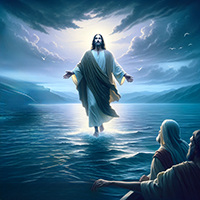 Two of Jesus’ most well-known miracles are the feeding of the five thousand and walking on water. These miracles further establish his divine power and his role as the provider and protector of his followers.
Two of Jesus’ most well-known miracles are the feeding of the five thousand and walking on water. These miracles further establish his divine power and his role as the provider and protector of his followers.
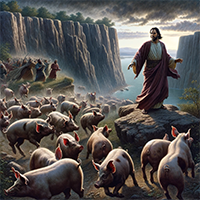 This event occurs when Jesus encounters a man possessed by a legion of demons. Recognizing Jesus' divine authority, the demons plead not to be sent away but to be allowed to enter a nearby herd of pigs. Jesus grants this request, and upon the demons' entry, the pigs, numbering about two thousand, rush down a steep bank into a lake and are drowned. This dramatic incident not only demonstrates Jesus' power over evil spirits but also profoundly impacts the local community, leading to a mix of awe and fear among the people.
This event occurs when Jesus encounters a man possessed by a legion of demons. Recognizing Jesus' divine authority, the demons plead not to be sent away but to be allowed to enter a nearby herd of pigs. Jesus grants this request, and upon the demons' entry, the pigs, numbering about two thousand, rush down a steep bank into a lake and are drowned. This dramatic incident not only demonstrates Jesus' power over evil spirits but also profoundly impacts the local community, leading to a mix of awe and fear among the people.
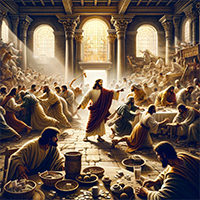 In Jerusalem, Jesus cleanses the Temple, driving out merchants and money changers. He engages in teaching and debates with religious leaders, further intensifying the conflict.
In Jerusalem, Jesus cleanses the Temple, driving out merchants and money changers. He engages in teaching and debates with religious leaders, further intensifying the conflict.
 Jesus shares the Passover meal with his disciples, during which he predicts his betrayal and institutes the Lord's Supper.
Jesus shares the Passover meal with his disciples, during which he predicts his betrayal and institutes the Lord's Supper.
 Jesus is betrayed by Judas, arrested, and subjected to a series of trials before the Jewish Sanhedrin and Roman governor Pontius Pilate. Despite being innocent, he is condemned to death and crucified.
Jesus is betrayed by Judas, arrested, and subjected to a series of trials before the Jewish Sanhedrin and Roman governor Pontius Pilate. Despite being innocent, he is condemned to death and crucified.
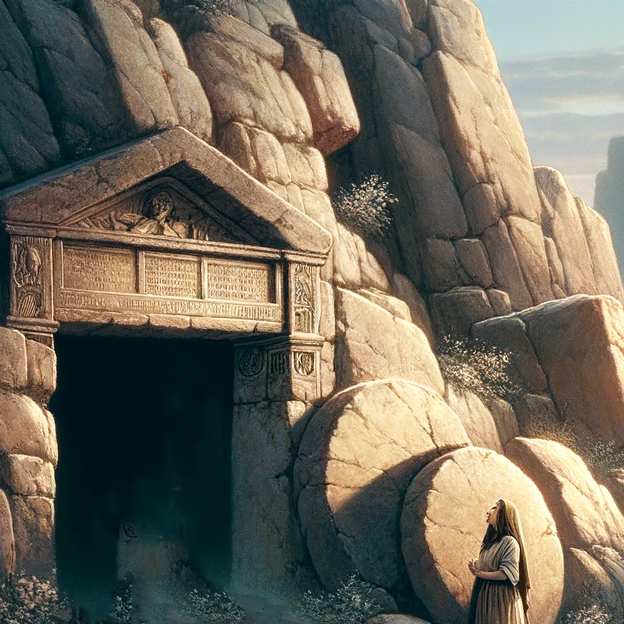 The Gospel concludes with the discovery of the empty tomb by women followers, and the announcement of Jesus' resurrection by an angel. Mark’s original ending is famously abrupt, with the women leaving the tomb in fear and silence.
The Gospel concludes with the discovery of the empty tomb by women followers, and the announcement of Jesus' resurrection by an angel. Mark’s original ending is famously abrupt, with the women leaving the tomb in fear and silence.
